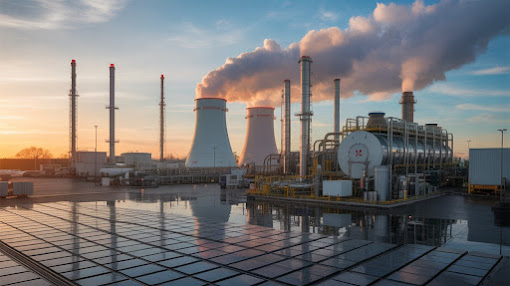Mass, Carbon, and Energy Balances | #sciencefather #researchawards #energy #phenomenological
♻️ Mass, Carbon, and Energy Balances of Thermochemical Processes for Digestate Valorization 🔥
In the evolving landscape of sustainable waste management and renewable energy, digestate valorization has emerged as a powerful tool 🌍. After the anaerobic digestion (AD) of organic waste produces biogas, the leftover digestate is rich in nutrients but still underutilized. That’s where thermochemical processes step in — offering a chance to convert digestate into valuable energy, fuels, and biochar 🌱. To fully optimize these processes, researchers must dive deep into the mass, carbon, and energy balances 🔍.
Why Focus on Digestate Valorization? 🚜
Digestate, although nutrient-dense, poses environmental challenges when mismanaged — like leaching and methane emissions 😟. Thermochemical treatments such as pyrolysis, gasification, and hydrothermal carbonization (HTC) help convert digestate into usable products. But to design efficient, eco-friendly systems, researchers must account for what goes in and what comes out — in terms of mass, carbon, and energy ✍️.
Mass Balance: Tracking Every Gram ⚖️
Mass balance is the foundation 🏛️. It ensures that all material inputs are accurately accounted for in the outputs.
🔵 Inputs: Digestate (solid and liquid fractions), oxygen (for gasification), sometimes catalysts.
🟢 Outputs: Biochar, syngas, bio-oil, water vapor, and ash.
Researchers construct mass balance models by quantifying the mass of feedstock and products. In pyrolysis, for instance, about 30–40% of the mass can remain as biochar, while the rest vaporizes into bio-oil and syngas 🌫️. Precise mass balances also reveal how moisture content affects yields and overall process efficiency 💧.
Key takeaway: A closed mass balance confirms a correctly operated system and helps scale up laboratory findings to pilot or industrial setups 🚀.
Carbon Balance: Following the Carbon Trail 🧬
Carbon is at the heart of digestate valorization 💖. During thermochemical processes, carbon atoms redistribute among solid, liquid, and gas phases.
🧩 Solid phase: Biochar retains a significant amount of carbon — a boon for carbon sequestration 🌳.
🧩 Liquid phase: Bio-oil contains complex organic carbon compounds.
🧩 Gas phase: CO, CO₂, CH₄, and other hydrocarbons form, contributing to the energy value 🔥.
Researchers must meticulously measure carbon fractions at every stage. Carbon balances shed light on:
✅ How much carbon is stabilized (good for soil improvement).
✅ How much carbon turns into fuels (good for energy generation).
✅ How much is lost as emissions (needs minimizing for climate goals).
An incomplete carbon balance might hint at hidden losses like leaks or unaccounted secondary reactions, leading to misleading conclusions ❗.
Energy Balance: Powering Up 🔋
At the end of the day, it's all about energy ⚡. Thermochemical processes must ideally produce more energy than they consume. Energy balances involve:
🔵 Input energy: Thermal energy to reach high temperatures (300–800°C), sometimes mechanical energy (mixing, feeding systems).
🟢 Output energy: Chemical energy stored in biochar, bio-oil, and syngas.
For example, gasification can convert digestate into syngas with a heating value of 4–10 MJ/Nm³ 🧯, while HTC requires lower temperatures but significant water handling energy.
By comparing the energy input with the energy recoverable from the products, researchers assess the net energy gain or loss 🔥➖⚡.
Energy efficiencies around 60–80% are common targets in optimized systems. Achieving positive energy balances is key to the economic and environmental sustainability of digestate valorization 🚀🌿.
Challenges and Research Directions 🧠
Despite the potential, challenges remain:
🚧 Heterogeneity of digestate feedstock affects process consistency.
🚧 Trade-offs between maximizing biochar yield (carbon sequestration) vs. maximizing energy output (bio-oil/gas).
🚧 Precise control and measurement tools are needed for accurate balances.
Researchers are now exploring advanced modeling tools, real-time sensors, and machine learning algorithms 🤖 to better predict and optimize mass, carbon, and energy flows. Integrating Life Cycle Assessment (LCA) methods also provides a holistic sustainability view 🌎.
Final Thoughts 🌟
Mastering the mass, carbon, and energy balances of thermochemical digestate valorization is crucial for designing the next generation of waste-to-energy technologies 🔥➡️⚡. It’s not just about getting rid of waste — it’s about turning challenges into opportunities 🌱💡. With robust research and innovation, digestate could become a goldmine for sustainable energy and soil health.
🔬 Keep balancing, keep innovating!
#Phenomenology#ResearchAwards#
Twitter: https://x.com/compose/post
Instagram: https://www.instagram.com/
Pinterest: https://in.pinterest.com/
Blogger: https://phenomenological21.




Comments
Post a Comment